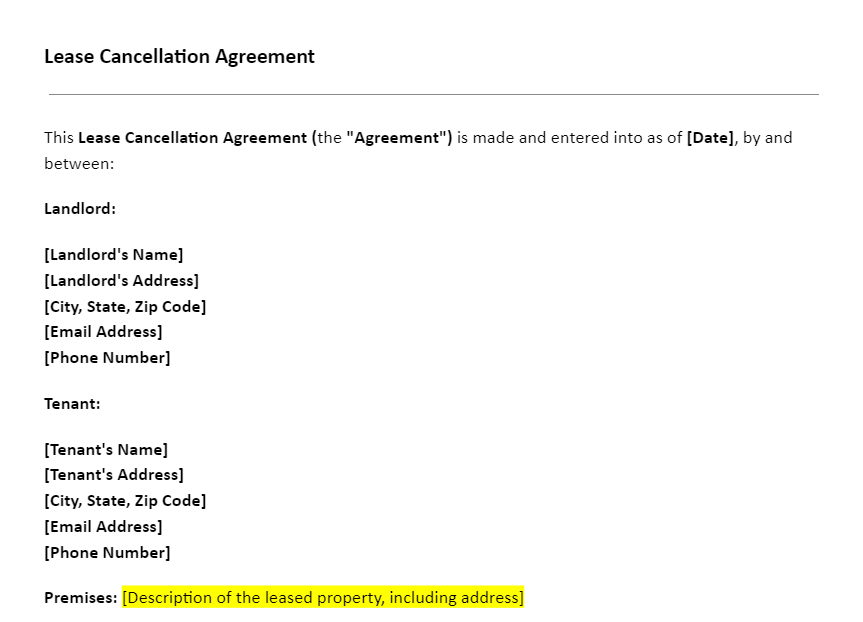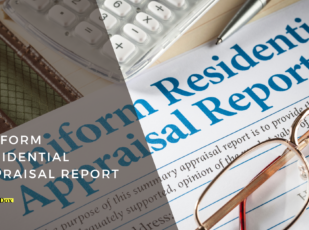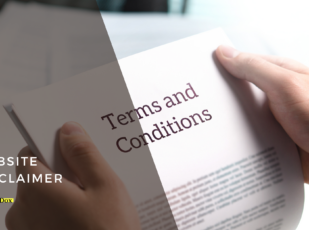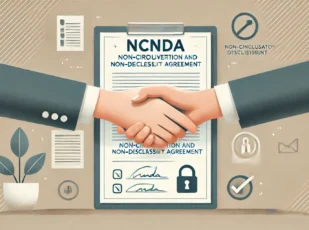
Lease Cancellation Agreement Template
15 Downloads
Commercial, Real Estate
February 17, 2025
Sayantani Dutta
A lease termination agreement is a formal mechanism for both the tenant and landlord to legally terminate their tenancy agreement properly. In the lack of a definite agreement, conflicts can arise over the deposit amount, rent, or the state of the property.
Formalizing lease termination protects both parties’ interests through the provisions of this agreement, specifying move-out terms, duration of termination notice, and any penalty for early termination. It also acts as a protective mechanism for future legal conflicts, outlining under what terms of the lease a termination of the lease agreement must be delivered and when an early termination can occur.
Whether initiated by the tenant or the landlord, a signed agreement prevents complications like wrongful eviction claims. This guide addresses key aspects of a lease termination agreement.
Why a Lease Cancellation Agreement is Needed
A lease termination letter creates a legally acceptable format for the termination of lease agreement. Without this agreement, both parties can have conflicting understandings regarding payments for unpaid rent, security deposits, and respective duties. Establishing clear terms helps avert conflicts, keeps both parties in compliance with the agreement, and protects them from unnecessary lawsuits.
Legal Clarity for All Parties
An informal verbal termination can cause uncertainty, and there can be room for dispute regarding the terms of the lease. A well-drafted termination agreement will include a termination notice, move-out conditions, and any requirements that must be fulfilled before the agreement is executed. This ensures both parties understand the subject matter and prevents claims for wrongful termination of tenancy.
Avoiding Financial and Legal Conflicts
Unresolved financial discrepancies can lead to legal confrontations between the landlord and the tenant. A lease termination letter will have to include an amount for returning a deposit, any withholding for unpaid rent or damages, and a mechanism for dealing with any arrears. Addressing these financial concerns in a signed agreement keeps costly lawsuits at bay and protects both parties from future claims on property condition and rent.
Outlining Terms for Early Termination
In cases like work relocations, financial hardship, or other unforeseen circumstances, tenants will have to vacate the rented property before the termination date. The agreement must state whether early termination is an option, any fee payable, and the termination period that must be obeyed. Landlords may make provisions in the contract for securing a new occupant and payment of rent until a new one is found.
Guarding Security Payments and Security Deposits
Disagreements often occur over the tenancy termination deposit. A lease termination letter guarantees that the rental property needs to be returned in good condition and that any wear and tear allowances are specifically outlined. It also sets when and under what conditions a deposit amount must be repaid, offering transparency in the transaction.
Managing Liabilities and Property Conditions
A properly prepared termination agreement protects landlords from unexpected liabilities when a tenant moves out. It should include provisions addressing unpaid utility payments, maintenance responsibilities, and the tenant’s obligation to these expenses that may affect the return of the deposit amount. Resolving these issues ensures a smooth transition and prevents disputes over property maintenance.
How to Write a Lease Cancellation Contract
Drafting a lease termination letter requires careful detail to avoid future conflicts. Each section plays a crucial role in creating an enforceable agreement that protects both parties.
Reviewing the Original Lease Terms
Before drafting, review the terms of the lease to determine the conditions for termination. Many rental agreements have provisions of this agreement that allow early termination, which may include financial penalties and a required termination notice period.
If an addendum was added to the lease, any changes impacting the termination of the lease agreement must also be considered. Understanding these factors prevents unintended violations of the terms of the lease.
Drafting the Contract
A lease termination letter must specifically state all parties involved and the rental property being vacated. The tenant’s name, landlord’s contact information, and property details must be included to validate the document.
Establishing the end date is another key consideration to avoid uncertainty about when the tenancy officially ends. To maintain transparency, provisions of this agreement must specify that once signed, the lease termination letter overrides any conflicting terms in the original lease.
Identification of the Parties
The agreement will have to start with a statement of both parties’ full legal names. If a property management service acts for a landlord, then its contact information must be included too. Correct identification ensures no confusion and misconceptions about who is responsible for complying with the terms of the lease agreement.
Property Details and Lease Reference
Clearly stating the location of the rented property and any information regarding the original agreement assists in connecting termination documentation with the correct tenancy. Referencing the date of the signing in the initial leasing agreement places in proper perspective terms for termination and acknowledges the legally binding nature of preceding commitments.
Termination Date and Cancellation Reason
A lease termination agreement will have an agreed termination date, and both parties are aware of when the tenancy legally ends. The document must state the cause for termination, whether early termination, expiration of a lease, an agreement between both parties, or for any specific reason. Clarity aids in resolving any future dispute regarding lease defaults or requirements.
Financial Settlement Terms
Handling financial matters transparently is essential in preventing future claims. This section should outline any outstanding rent payments, prorated amounts for partial months, and any penalties associated with early termination. If an early termination fee is involved, specify both the amount and payment date in the agreement. Any remaining security deposit, any deductions for any damages, and any refund timelines must be documented to maintain financial transparency for both parties involved.
Responsibilities for Repairs and Maintenance
A lease termination doesn’t exempt a tenant from returning property in a satisfactory condition. The agreement should outline any necessary repairs, expected maintenance, and who is responsible for completing them. If deductions for damages, when applicable, have been taken, these must specifically be documented in this section.
Final Inspection and Key Handover
A walkthrough of the rental unit should be conducted before the tenant vacates. The lease termination agreement must detail how a final inspection will be conducted, and any terms and conditions under which a security deposit will be returned. Key return protocols must then be established, excluding access to the post-termination date.
Release of Liability for Both Parties
Any waivers of future claims have to be explicitly mentioned, providing both the landlord and tenant with legal protection.
Dispute Resolution
Definitions If disagreements arise regarding the termination of the lease, a proper resolution mechanism can save lengthy and expensive court battles. The agreement will have to specify dispute resolution, including options such as arbitration, mediation, and court proceedings. Defining resolution processes in advance provides both parties with a clear direction in resolving conflicts.
Signatures
For the termination of a lease to have a legally effective date, both parties have to sign and date it. If witness signatures and notarization must be included, include them in your requirements. Ensuring proper fulfillment of the agreement brings termination to a conclusion and forms an explicit record of agreement between both parties, namely, the tenant and landlord.
Common Mistakes in Drafting Lease Cancellation Agreements
Errors in canceling a lease can have financial consequences and legal complications, and for that reason, correct any mistakes in advance. A well-structured agreement helps to avert misunderstandings and sets out definite terms for both tenants and landlords.
Not Reviewing the Original Lease Contract
Overlooking the terms of a lease can lead to violations that can have penalties and cause conflicts. Certain covenants in the first agreement can restrict early termination or require specific terms to be met for termination of the agreement to take place. A thorough review of the affirms that the termination of a lease agreement is aligned with both parties’ rights and terms.
Failing to Detail Financial Requirements
Unclear financial terms can cause disputes over unpaid rent, security deposit withholdings, and unpaid fees. The agreement should specify any unpaid balance, any prorated rent, and any additional cost incurred during termination. Financial disputes can be avoided through payment terms documentation and defining any warranties for damages and refunds.
Overlooking Property Condition Requirements
Neglecting to record the move-out state of a rented unit can lead to disputes over damages. The agreement must include provisions for returning the property in a satisfactory state and for any security deposit deductions. Include clear statements about inspections and maintenance requirements to maintain transparency.
Not Including a Clear Termination Date
Leaving the termination date in limbo can generate uncertainty about the financial and contractual obligations of the renter. The agreement will have to state when the tenancy will cease and any applicable timelines. Vagueness in such a case can result in unnecessary legal complications.
Ignoring Legal Review Before Signing
A lease termination agreement is a legally binding agreement, and failure to seek legal consultation can make both parties susceptible to vulnerability. Consulting a real estate lawyer ensures that the agreement is tailor-made to abide by relevant laws and that the entire agreement is legally enforceable. A properly drawn agreement shields both parties’ rights and lessens the chance for lawsuits.
Importance of a Well-Derived Lease Cancellation Process and Need for a Template for an Agreement
A lease termination agreement creates a formal mechanism for putting in writing the terms under which a lease will terminate. Clear contractual terms can define roles and responsibilities, lessening the opportunity for dispute. A template is a reliable starting point, and tenants and landlords can use it to adapt the agreement to specific circumstances. By standardizing terms, a professionally prepared form ensures uniformity and transparency in canceling leases. Legal guidance strengthens the enforceability of the agreement and protects the rights of both parties.
Download a Free Lease Termination Agreement Template from FreshDox
Sign up for a free 7-day trial of FreshDox. You’ll get immediate access to this fully customizable template, just edit it to your requirements and download it in Word or PDF format. If you get value from this template, you’ll enjoy our complete catalog of templates for real estate. Basic accounts qualify for three downloads a week and Unlimited accounts get as many downloads as you need. Sign up for a risk-free trial of FreshDox and get professionally designed templates for your real estate business.
Popular searches:
- Lease Cancellation Agreement Template pdf
- Lease Cancellation Agreement Template sample
- Lease Cancellation Agreement Template download
- Lease Cancellation Agreement Template format
- Lease Cancellation Agreement Template template
- Lease Cancellation Agreement Template word
- Lease Cancellation Agreement Template free
Related Templates
Discover more templates that align with your needs and preferences.

Ready to Sign Up?
Sign up for FreshDox.com’s 7-day trial and discover why so many individuals and businesses trust us for their legal document template needs.
- Cancel any time
- 7-day free trial
- From 300+ Customer Reviews
















